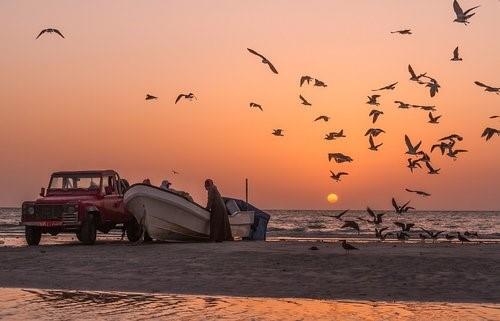
Oman- Masirah Island: Key environmental and tourist site in the sultanate
The island has the second largest gathering in the world and the largest in the Indian Ocean of the loggerhead turtle where about 30,000 to 60,000 turtles nest annually.
There are two more types of turtles. Around 150 olive turtles lay their eggs on the shores of Masirah Island annually, while the hawksbill turtle nestles on Masirah Island and the Damaniyat Islands. Their gathering in the sultanate is considered to be the largest in the world, with 500 to 1,500 eggs per year.The green turtle nestles on most of Masirah beaches, but in small numbers compared to its largest gathering at Ras al Hadd.
A report published by the Ministry of Environment and Climate Affairs said that the sultanate has made efforts to preserve and protect its sea turtles. It has also taken the lead in many aspects related to the management of the turtles' habitats.According to the International Union for Conservation of Nature, the turtles nesting in Oman are all at risk, and the Damaniyat Islands are more vulnerable to the critically endangered category.
The sultanate has shouldered this responsibility as the most important place among the countries of the region for nesting sea turtles, particularly the loggerhead turtle, the green turtle, and the hawksbill turtle.The sultanate was the first to survey and count the turtles on its shores, and to carry out an ambitious long-term marine turtle breeding programme in Oman.
With its unique geographical location, Masirah Island is an important place for bird watching and studying birds, where a large number of birds, namely herons, flamingos, gulls and barn swallows, as well as migratory birds coming from the Arabian Peninsula, India, Pakistan, East Africa, the plains of Siberia, and Europe.Dr Hamad bin Mohammed al Ghailani, director of Community Affairs and Environmental Awareness at the Environment Society of Oman said that the eastern sea of Masirah Island is an important site for humpback whale, which is believed to be a type of humpback whale separated from other species around the world. It is considered to be the most common type of whale found in the sultanate (estimated 200 whales).
In the same location there is a kind of dolphin called bottlenose.The small island of Marsis, which is located in the western part of the middle of the Masirah Island, is a breeding area of sea birds, including the sooty gull and roseate tern.

Legal Disclaimer:
MENAFN provides the
information “as is” without warranty of any kind. We do not accept
any responsibility or liability for the accuracy, content, images,
videos, licenses, completeness, legality, or reliability of the information
contained in this article. If you have any complaints or copyright
issues related to this article, kindly contact the provider above.


















Comments
No comment